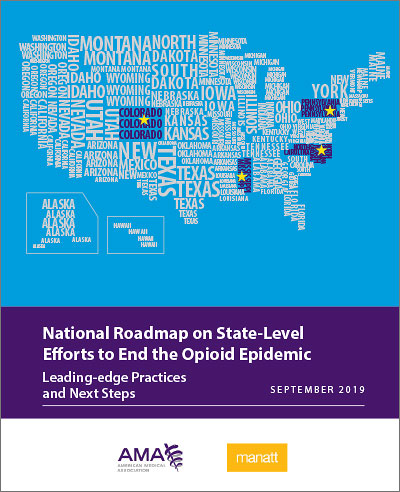AMA Identifies Six State Strategies for Ending Opioid Epidemic
Abstract
The report highlights tools and strategies devised by states that have already achieved success in reducing opioid deaths and turning the tide of the epidemic.
Network adequacy—whether health plans have enough health care professionals in their network to meet demand—and enforcement of parity laws are among the keys to addressing the opioid epidemic, according to an analysis by the AMA and Manatt Health, a health care consulting firm.
The “National Roadmap on State-Level Efforts to End the Opioid Epidemic: Leading Edge Practices and Next Steps” analyzes the response to the epidemic in four states—Colorado, Mississippi, North Carolina, and Pennsylvania—and highlights six strategies that appear to be critical to success. The two already noted—enforcement of parity laws and network adequacy—are also among APA’s top legislative priorities.

“States have to be willing to use their oversight to enforce parity laws,” psychiatrist and AMA President Patrice Harris, M.D., M.A., told Psychiatric News. “The work APA has been doing in this area to develop tools that physicians can use to evaluate whether states are complying with parity has been invaluable.” Harris is also chair of the AMA Task Force to Reduce Opioid Abuse.
Complementary to parity enforcement is ensuring that health plans have adequate numbers of mental health professionals in their networks. This is likely to require payment reforms, collaborative care models, and other efforts to bolster and support the nation’s treatment workforce for opioid use disorder (OUD), according to the report.
Four other effective strategies identified in the roadmap are the following:
Improving access to evidence-based treatment for opioid use disorder. Remove prior authorization requirements and other barriers to medication for addiction treatment (MAT) for OUD—and ensure MAT is affordable.
Expanding pain management options. Enhance access to comprehensive pain care, including nonopioid and nonpharmacologic options.
Improving access to naloxone. Reduce harm by expanding access to the overdose-reversing drug and coordinating care for patients in crisis.
Evaluating policy success and barriers. Evaluate policies and outcomes to identify what is working and build on successful efforts, and identify policies and programs that might need to be revised or rescinded.
“We are at a crossroads in our nation’s efforts to end the opioid epidemic, and states are being creative on how they respond,” Harris said in a statement. “It is time to end delays and barriers to treatment; time for payers, pharmacy benefit managers, and pharmacy chains to revise policies that restrict opioid therapy to patients based on arbitrary thresholds; and time to help all patients access evidence-based care for pain and substance use disorders. Physicians must continue to demonstrate leadership, but unless and until these actions occur, the progress we are making will not stop patients from dying.”
Joel Ario, managing partner at Manatt Health Strategies and former insurance commissioner in Oregon and Pennsylvania, added: “These recommendations are already proving effective in leading states. If state policymakers want to have a tangible impact on improving patient care, these are the policies that are showing real promise. This is not hypothetical—this is what is needed to end the epidemic.”
The recommendations by the AMA and Manatt emerged from four key themes identified in an earlier analysis of strategies in the four states. The broad themes include the following:
Vigorous state oversight and enforcement. State regulators can have a significant impact on reducing barriers and improving patient care, and some have used these tools to increase access to evidence-based treatment. Regulators have successfully held payers and others accountable for restricting access by using prior authorization for MAT. Additionally, states have found success by enforcing state and federal insurance parity laws, benefitting patients needing treatment for mental or substance use disorders.
Medicaid expansion. Medicaid often provides more comprehensive care for substance use disorders than the commercial insurance market, often by removing barriers to MAT and providing greater access to nonopioid pain care. Expanding Medicaid in states that have not yet done so would establish a strong foundation to help even more patients.
Long-term funding. Grants are being used to advance many best practices, but to continue saving lives, states need long-term, sustainable funding. Without reliable funding streams, programs that are showing promise to reduce overdose and death—and to connect patients to treatment—might simply disappear.
Measuring success. Some states are evaluating policies and programs to determine what works. Most of these evaluations are just beginning. Comprehensive analysis is essential to focus resources on successful interventions and to revise or drop policies that are having unintended consequences. ■
The AMA report is posted here.



